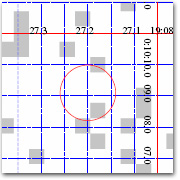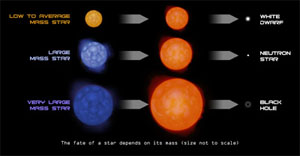Disclaimer: This material is being kept online for historical purposes. Though accurate at the time of publication, it is no longer being updated. The page may contain broken links or outdated information, and parts may not function in current web browsers. Visit chandra.si.edu for current information.
On Black Hole-ness:
Taking Pleasure in the Dimness of the Stars
by WKTAugust 8, 2007 ::

Zoom-in on the position of the neutron star SXT 1H 1905+000 in the 0.3-7 keV 300 ks Chandra ACIS image. The circle has a radius of 0.91".
"...we shall find a pleasure in the dimness of the stars."
Samuel Taylor Coleridge, The Nightingale
In astronomy, the challenge is usually to explain the unexpected brightness of an object - for example the nucleus of a galaxy that emits intense radiation, or an anomalously luminous supernova. Sometimes, though, the unexpected dimness of objects can lead to important discoveries, as in the observation that distant supernovas are dimmer than predicted - a discovery that suggests that a mysterious "dark energy" dominates our universe.
The recent failure to detect X-rays from the neutron star 1H1905 +00 (1H1905 for short) may pose a problem for a significant body of work on a fundamental issue - the quest to prove that black holes exist.
Most readers of the Chandra X-ray Center web pages probably take it for granted that black holes exist. But are the "black holes" Chandra is observing really black holes?
There is the nagging problem of reconciling quantum theory with Einstein's General Theory of Relativity in the extreme gravity limit of black holes. This has led some theoretical physicists to propose that black holes may not exist after all. For example, massive collapsing stars may instead form "gravastars" composed of a shell of superdense matter on the outside and dark energy on the inside.
Meanwhile, astrophysicists have been locating and studying black hole candidates in our galaxy and beyond. They look for an object in which the concentration of mass is so great that the mass cannot be stabilized against gravity using any known forces. Einstein's General Theory of Relativity then requires that the object must collapse to form a black hole.
For example, a collapsed star with a mass less than about 3 times the mass of the sun can be stabilized as a neutron star by nuclear forces. If the mass is greater than this critical mass, the object is presumed to be a black hole. About two dozen black hole candidates have been identified this way. However, all we really know is that the collapsed objects are too massive to be neutron stars.
For definite proof of black hole-ness, it must be demonstrated that the black hole possesses an event horizon, a boundary in space-time that acts like a one-way membrane separating the black hole from the rest of the universe. Matter, radiation, and energy can fall into the black hole from beyond the event horizon, but nothing, not even light can get out.
When viewed from typical distances of thousands of light years, the shadow of the approximately 50-kilometer diameter of the event horizon of a stellar black hole is much too small to be imaged by telescopes. However, thanks to the ingenuity of astrophysicists, indirect detection might be possible, even feasible.
The important feature of the event horizon is that it is not a surface in the usual sense of the word, such as the surface of the ocean. A particle encountering the event horizon would not collide with anything, it would just coast right through as though nothing were there, because nothing is.
One method to prove that a collapsed massive object has an event horizon, and is by implication a black hole is to show that it does not have a surface. This is possible because nature has provided us with some excellent probes of the surfaces of compact objects such as neutron stars. These probes are called X-ray binaries.
An X-ray binary is a binary star system in which a normal star is locked in a tight orbit around a massive collapsed object such as a neutron star or black hole. The normal star is losing its gaseous atmosphere to its companion.
As the gas falls toward the neutron star or black hole, it will pick up speed and be heated to extremely high temperatures. If the gas accumulates in a disk around the neutron star or black hole it will spiral inward slowly and produce an intense amount of X-rays. Many of the brightest X-ray sources in our galaxy are generating X-rays this way.
In a recent review, Ramesh Narayan of the Harvard-Smithsonian Center for Astrophysics (CfA) outlined 5 different ways to use X-ray binaries to search for event horizons. Three of these contrast details of the variability and distribution with energy of the X-rays emitted by gas crashing onto the surface of a neutron star with those of gas diving through a black hole event horizon.
Another way in which neutron stars and black holes can be distinguished is the presence or absence of so-called Type 1 X-ray bursts. When gas pulled from a companion star settles onto the surface of a neutron star, it forms a dense, hot layer. If this layer reaches a critical mass, it becomes a thermonuclear bomb that blows away the accreted material and emits a burst of X-rays.
The same process should occur for gas falling onto any compact object that has a surface instead of an event horizon. Yet although thousands of bursts have been observed from neutron stars, not one has been observed from a black hole candidate. The lack of X-ray bursts from black hole candidates is a strong argument against the existence of gravastars and other exotic alternatives to black holes.
Another potentially powerful test for the existence of black hole event horizons comes from the study of X-ray novae. These systems, which are a subclass of X-ray binaries, tend to flare up and become extremely bright, typically for a few months, and then fade away for years and even decades before flaring up again.
The explanation for this behavior is that the hot disk of gas around the compact object disappears during the quiescent state. In this state, some gas continues to flow toward the compact object at a very low rate, producing a weak source of X-rays. Because the inflowing gas produces additional X-radiation when it crashes into the surface of a neutron star, quiescent neutron stars should be much brighter than a black hole candidate, which has no surface.
Observations show that X-ray binary systems with similar orbital periods are likely to have similar flows of infalling gas. Using this information, Narayan, together with Jeff McClintock and Mike Garcia of CfA proposed that a comparison of the quiescent X-ray luminosities of neutron star novae and black hole novae can provide a test for the existence of black hole event horizons. Neutron stars and black hole candidates in quiescence should have comparable X-ray luminosities, if both types of objects have surfaces.
The data show that quiescent neutron star novae are 100 or more times brighter than their black hole counterparts, as expected if black holes have event horizons. This result has been considered strong evidence for the existence of black hole event horizons.
The dimness of 1H1905 could pose a problem for this compelling picture, however. In fact, in a recent report on Chandra's stringent new limit on X-radiation from 1H1905, Peter Jonker of CfA and Utrecht University in the Netherlands and his colleagues argue that it may even be a show stopper!
"...the claim that there is evidence for the presence of a black hole event horizon on the basis of a lower quiescent luminosity for black holes than for neutron stars is unproven," they conclude.
While acknowledging that the work of Jonker and colleagues on 1H1905 is important, McClintock takes exception to their strong conclusions. He points out that optical observations suggest an orbital period for 1H1905 of about one hour, whereas the orbital periods in his team's sample range from 4 to 12 hours. Since no known black hole system has such a tight orbit as 1H1905, comparing the systems may be like comparing apples and oranges.
It is too early to know whether 1H1905 is the exception that proves the rule, or breaks the rule, and which side of this controversy will take the most pleasure of the dimness of this particular star. What we do know is that the proof of the existence of black hole event horizons must rest on several independent pillars of evidence.
REFERENCES:
P. Jonker et al. 2007 arXiv:0706.3421v1 [astro-ph]
J. McClintock et al. 2007, Chandra News, March 2007 issue, p. 1
http://cxc.harvard.edu/newsletters/
Ramesh Naryan, STScI Spring Symposium 2007 an online movie of his lecture is at:
http://www.stsci.edu/institute/itsd/information/streaming/archive/SpringSymposium2007
Disclaimer: This material is being kept online for historical purposes. Though accurate at the time of publication, it is no longer being updated. The page may contain broken links or outdated information, and parts may not function in current web browsers. Visit chandra.si.edu for current information.







